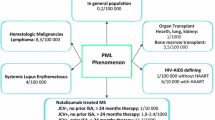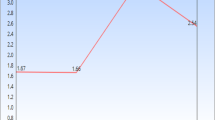Abstract
Three patients have developed progressive multifocal leukoencephalopathy while being treated with natalizumab for their autoimmune diseases. One patient had relapsing-remitting multiple sclerosis (RRMS), one had Crohn’s disease, and one (who had been enrolled in an RRMS phase III trial) had no evidence of multiple sclerosis on autopsy. The patient with RRMS now has severe, permanent neurologic damage and the other two patients died. In this article, we recommend revised entry and diagnostic criteria to prevent enrollment of RRMS patients with a favorable prognosis or questionable diagnosis into trials of drugs with unknown safety profiles. In light of the risk of progressive multifocal leukoencephalopathy, we strongly recommend that RRMS patients who are at low risk of disability not be treated with natalizumab. Finally, we discuss what additional natalizumab efficacy data need to be presented before any decisions should be made about treating RRMS patients with a high risk of developing long-term disability.
Similar content being viewed by others
References and Recommended Reading
Kleinschmidt-DeMasters BK, Tyler KL: Progressive multifocal leukoencephalopathy complicating treatment with natalizumab and interferon beta-1a for multiple sclerosis. N Engl J Med 2005, 353:369–374. The case report of the woman in Colorado without any evidence of MS on autopsy.
Langer-Gould A, Atlas SW, Bollen AW, Pelletier D: Progressive multifocal leukoencephalopathy in a patient treated with natalizumab. N Engl J Med 2005, 353:375–381. The case report of the man with RRMS in California who developed an aggressive inflammatory reaction to PML 3 months after cessation of natalizumab.
Van Assche G, Van Ranst M, Sciot R, et al.: Progressive multifocal leukoencephalopathy after natalizumab therapy for Crohn’s disease. N Engl J Med 2005, 353:362–368. The case report of the Belgian man with a complicated treatment history for Crohn’s disease who died of PML while on natalizumab monotherapy.
Arend SM, Kuijper EJ, Allaart CF, et al.: Cavitating pneumonia after treatment with infliximab and prednisone. Eur J Clin Microbiol Infect Dis 2004, 23:638–641.
Baghai M, Osmon DR, Wolk DM, et al.: Fatal sepsis in a patient with rheumatoid arthritis treated with etanercept. Mayo Clin Proc 2001, 76:653–656.
Marie I, Heliot P, Roussel F, et al.: Fatal Mycobacterium peregrinum pneumonia in refractory polymyositis treated with infliximab. Rheumatology (Oxford) 2005, 44:1201–1202.
Khanna D, McMahon M, Furst DE: Safety of tumour necrosis factor-alpha antagonists. Drug Saf 2004, 27:307–324.
Uthman I, Husari A, Touma Z, Kanj SS: Fatal streptococcal toxic shock syndrome in a patient with rheumatoid arthritis treated with etanercept. Rheumatology (Oxford) 2005, 44:1200–1201.
Brooks BR, Walker DL: Progressive multifocal leukoencephalopathy. Neurol Clin 1984, 2:299–313.
Major E, Ryschkewitsch D, Fahle G, et al.: The laboratory evaluation for JC Virus DNA in cerebrospinal fluid and plasma from multiple sclerosis patients participating in the phase III clinical trials of natalizumab [abstract]. Multiple Sclerosis 2005, 11(Suppl 1):679.
Feldmann M, Steinman L: Design of effective immunotherapy for human autoimmunity. Nature 2005, 435:612–619. A review of contemporary advances in immune therapy, discussing the inherent dangers when a drug targets a potential tipping point in the immune response.
Steinman L: Blocking adhesion molecules as therapy for multiple sclerosis: natalizumab. Nat Rev Drug Discov 2005, 4:510–518. Development of natalizumab from bench to bedside, by one of the co-discoverers.
Berger T, Deisenhammer F: Progressive multifocal leukoencephalopathy, natalizumab, and multiple sclerosis. N Engl J Med 2005, 353:1744–1746; author reply 1744–1746.
Pittock SJ, McClelland RL, Mayr WT, et al.: Clinical implications of benign multiple sclerosis: a 20-year population-based follow-up study. Ann Neurol 2004, 56:303–306.
Black WC, Welch HG: Screening for disease. Am J Roentgenol 1997, 168:3–11.
Gaudino EA, Chiaravalloti ND, DeLuca J, Diamond BJ: A comparison of memory performance in relapsing-remitting, primary progressive and secondary progressive, multiple sclerosis. Neuropsychiatry Neuropsychol Behav Neurol 2001, 14:32–44.
Langer-Gould A, Popat R, Huang S, et al.: Clinical and demographic predictors of long term disability in patients with relapsing-remitting multiple sclerosis: a systematic review. N Engl J Med 2006, In press.
Achiron A, Barak Y, Rotstein Z: Longitudinal disability curves for predicting the course of relapsing-remitting multiple sclerosis. Mult Scler 2003, 9:486–491.
Eriksson M, Andersen O, Runmarker B: Long-term follow up of patients with clinically isolated syndromes, relapsing-remitting and secondary progressive multiple sclerosis. Mult Scler 2003, 9:260–274.
Runmarker B, Andersen O: Prognostic factors in a multiple sclerosis incidence cohort with twenty-five years of follow-up. Brain 1993, 116(Pt 1):117–134.
McDonald WI, Compston A, Edan G, et al.: Recommended diagnostic criteria for multiple sclerosis: guidelines from the International Panel on the diagnosis of multiple sclerosis. Ann Neurol 2001, 50:121–127.
Chang CL, Donaghy M, Poulter N: Migraine and stroke in young women: case-control study. The World Health Organisation Collaborative Study of Cardiovascular Disease and Steroid Hormone Contraception. BMJ 1999, 318:13–18.
Carolei A, Marini C, De Matteis G: History of migraine and risk of cerebral ischaemia in young adults. The Italian National Research Council Study Group on Stroke in the Young. Lancet 1996, 347:1503–1506.
Tzourio C, Tehindrazanarivelo A, Iglesias S, et al.: Casecontrol study of migraine and risk of ischaemic stroke in young women. BMJ 1995, 310:830–833.
Kruit MC, van Buchem MA, Hofman PA, et al.: Migraine as a risk factor for subclinical brain lesions. JAMA 2004, 291:427–434. A population-based cross-sectional study that characterizes the type of imaging abnormalities found in higher frequency in migraine patients as compared with age- and sex-matched control subjects. It also identifies clinical and demographic features of migraine patients at highest risk of subclinical brain lesions.
Nilsson P, Larsson EM, Maly-Sundgren P, et al.: Predicting the outcome of optic neuritis evaluation of risk factors after 30 years of follow-up. J Neurol 2005, 252:396–402. This is a retrospective cohort study of optic neuritis patients that describes their brain imaging characteristics, clinical diagnoses, and prognosis after 30 years. It shows that many of the optic neuritis patients who never suffered any recurrent symptoms meet current MS MRI diagnostic criteria, thus calling into question the prognostic significance of these criteria.
Beck RW, Smith CH, Gal RL, et al.: Neurologic impairment 10 years after optic neuritis. Arch Neurol 2004, 61:1386–1389.
Brex PA, Ciccarelli O, O’Riordan JI, et al.: A longitudinal study of abnormalities on MRI and disability from multiple sclerosis. N Engl J Med 2002, 346:158–164.
Polman CH, O’Connor PW, Havrdova-Eat AI: Clinical results from AFFIRM: a randomized, placebo-controlled, multicenter trial to determine the efficacy and safety of natalizumab in patients with relapsing multiple sclerosis. American Academy of Neurology, Miami Beach, Florida 2005, 64:A146. Abstract S116.003.
Rudick R, Stuart W, Calabrese Pat SI: SENTINEL: a randomized, double-blind, placebo-controlled, multicenter trial to determine the efficacy and safety of natalizumab, when added to intramuscular interferon beta-1a, in patients with relapsing multiple sclerosis. One-year clinical and MRI results. American Academy of Neurology, Miami Beach, Florida 2005, 64: A276. Abstract S236.001.
Drazen JM: Patients at risk. N Engl J Med 2005, 353:417.
Author information
Authors and Affiliations
Corresponding author
Rights and permissions
About this article
Cite this article
Langer-Gould, A., Steinman, L. Progressive multifocal leukoencephalopathy and multiple sclerosis: Lessons from natalizumab. Curr Neurol Neurosci Rep 6, 253–258 (2006). https://doi.org/10.1007/s11910-006-0013-z
Issue Date:
DOI: https://doi.org/10.1007/s11910-006-0013-z




